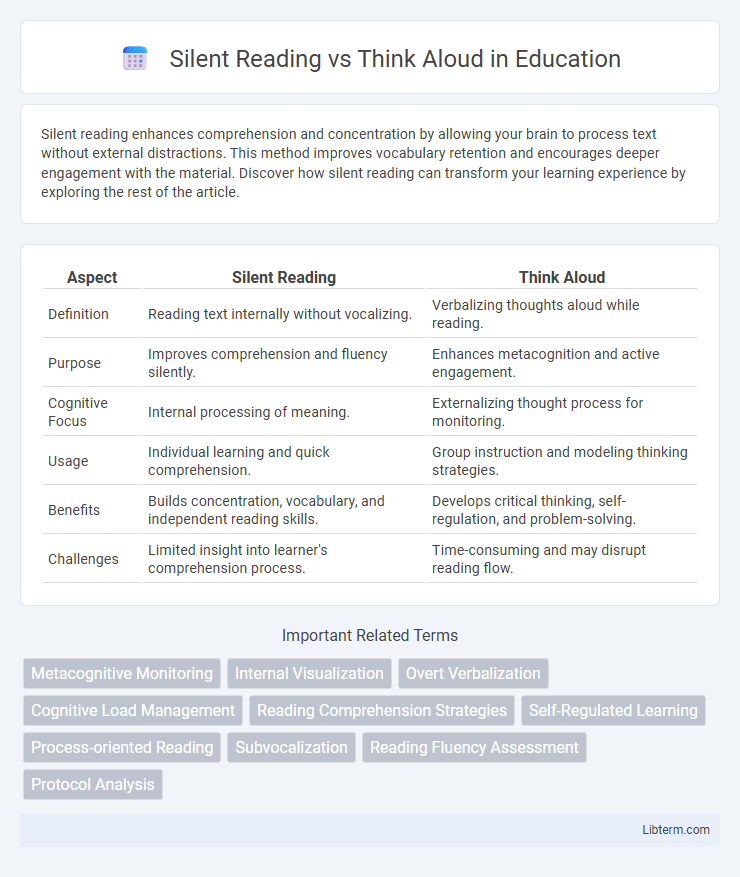Silent reading enhances comprehension and concentration by allowing your brain to process text without external distractions. This method improves vocabulary retention and encourages deeper engagement with the material. Discover how silent reading can transform your learning experience by exploring the rest of the article.
Table of Comparison
| Aspect | Silent Reading | Think Aloud |
|---|---|---|
| Definition | Reading text internally without vocalizing. | Verbalizing thoughts aloud while reading. |
| Purpose | Improves comprehension and fluency silently. | Enhances metacognition and active engagement. |
| Cognitive Focus | Internal processing of meaning. | Externalizing thought process for monitoring. |
| Usage | Individual learning and quick comprehension. | Group instruction and modeling thinking strategies. |
| Benefits | Builds concentration, vocabulary, and independent reading skills. | Develops critical thinking, self-regulation, and problem-solving. |
| Challenges | Limited insight into learner's comprehension process. | Time-consuming and may disrupt reading flow. |
Introduction to Silent Reading and Think Aloud
Silent reading enhances comprehension by allowing readers to process text internally, fostering deeper cognitive engagement and autonomous learning. Think aloud involves verbalizing thoughts while reading, providing insight into cognitive processes and facilitating metacognitive awareness. Both methods optimize reading strategies, yet silent reading emphasizes independent comprehension, while think aloud supports active problem-solving and self-monitoring.
Defining Silent Reading
Silent reading involves the internal process of decoding and comprehending text without vocalizing words, allowing for faster reading speed and deeper concentration. It engages cognitive functions like visual processing and working memory to construct meaning from the text silently. Unlike the think aloud strategy, silent reading fosters independent comprehension by minimizing external distractions and verbal articulation.
What is Think Aloud Strategy?
The Think Aloud strategy involves verbalizing thoughts while reading, allowing readers to actively monitor comprehension and engage with the text. This method helps identify cognitive processes such as predicting, questioning, clarifying, and summarizing in real time. Think Aloud enhances critical thinking skills by making internal reasoning explicit, contrasting with Silent Reading where comprehension remains internal and unspoken.
Cognitive Processes in Silent Reading
Silent reading engages complex cognitive processes involving internal visualization, semantic interpretation, and memory retrieval without external verbalization. It activates neural pathways related to language comprehension, working memory, and attentional control to construct meaning internally. Unlike think aloud, which externalizes metacognitive strategies, silent reading relies heavily on implicit cognitive mechanisms for efficient comprehension and information processing.
Cognitive Processes in Think Aloud
Think Aloud engages cognitive processes such as metacognition, working memory, and verbalization, allowing readers to externalize their thought patterns and monitor comprehension actively. This method facilitates real-time problem-solving and self-explanation, enhancing deeper understanding and retention compared to silent reading. By verbalizing predictions, inferences, and connections, Think Aloud promotes higher-order cognitive skills vital for effective reading comprehension.
Benefits of Silent Reading
Silent reading enhances comprehension by allowing readers to process text internally at their own pace, which fosters deeper cognitive engagement. It improves concentration and minimizes distractions, supporting sustained attention and better retention of information. This method also promotes independent learning and vocabulary expansion without the pressure of verbalizing every thought.
Advantages of Think Aloud Method
The Think Aloud method enhances comprehension by making internal cognitive processes explicit, allowing readers to monitor and regulate their understanding actively. It promotes metacognitive skills and critical thinking by encouraging verbalization of thoughts, which helps identify misunderstandings in real-time. Educators can use this method to assess students' reasoning strategies and provide targeted feedback, improving overall learning outcomes.
Challenges and Limitations of Each Approach
Silent reading often poses challenges such as limited insight into a reader's thought process and difficulty in assessing comprehension in real-time. Think aloud methods, while providing valuable cognitive transparency, can disrupt natural reading flow and impose cognitive load, potentially altering the reading experience. Both approaches face limitations in accurately representing authentic reading behaviors across diverse texts and reader proficiencies.
Choosing the Right Strategy for Different Learners
Silent reading allows learners to process text internally, enhancing comprehension for those who excel with individual focus and minimal distraction. Think aloud strategies support students who benefit from verbalizing thoughts to reinforce understanding and develop metacognitive skills. Selecting between silent reading and think aloud depends on cognitive style, reading proficiency, and the specific learning objectives of each individual.
Conclusion: Silent Reading vs Think Aloud
Silent reading enhances comprehension by allowing readers to process text internally at their own pace, fostering deeper cognitive engagement. Think aloud strategies promote metacognitive awareness by encouraging readers to verbalize thoughts, which aids in identifying misunderstandings and improving critical thinking skills. The choice between silent reading and think aloud depends on educational goals, with silent reading benefiting fluency and concentration and think aloud supporting analytical and problem-solving abilities.
Silent Reading Infographic

 libterm.com
libterm.com